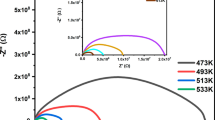Abstract
The electrical properties of silver ion conducting borate glasses are investigated by impedance spectroscopy in the temperature range 303–453 K. Impedance data are presented in the Nyquist plots. This representation allows the determination of the relaxation frequencies of the samples. The relaxation frequency follows an Arrhenius behavior. X-ray diffraction analysis shows that, due to the hygroscopic behavior of borate glasses, boric acid crystals are formed. In AgI-containing silver borate glasses, the β-AgI phase is formed and its structure mostly depends on the glass formation process, i.e., quenching or thermal treatment during melt quenching. In AgBr-containing glasses, a phase of AgBr is formed. The electrical properties of these glass systems can be described as a parallel RC circuit in which R represents the bulk resistance R B and C represents the bulk geometric capacitance C B of the sample. Impedance spectroscopy shows the Cole-Davidson type behavior.
Similar content being viewed by others
References
Ravaine, D. and Souquet, J.L., Application of Complex Impedance Diagrams to the Study of Electric and Dielectric Properties of Alkali Glasses, J. Chim. Phys. Phys.-Chim. Biol., 1973, vol. 71, p. 693.
Audier, M., Ravaine, D., and Souquet, J.L., C. R. Seances Acad. Sci., Ser. C, 1976, vol. 282, no. 1, p 499.
Ravaine, D. and Souquet, J.L., The Electron Paramagnetic Resonance Spectra of VO2+ of Alkali-Doped Bismuth Borate Glasses, Phys. Chem. Glasses, 1977, vol. 18, no. 2, pp. 27–31.
Ribe, M., Barra, B., and Souquet, J.L., Sulphide Glasses, Glass-Forming Regions, Structure, and Ionic Conduction of Glasses in the Na2S-XS2 (X = Si, Ge), Na2S-P2S5, and Li2S-GeS2 Systems, J. Non-Cryst. Solids, 1980, vol. 38–39, no. 1, pp. 271–276.
Downing, H.L., Peterson, N.L., and Jain, H., Mixed Isotopes and Electrical Conductivity in Lithium Borate Glasses, J. Non-Cryst. Solids, 1982, vol. 50, no. 2, pp. 203–213.
Robinel, E., Carette, B., and Ribe, M., Silver Sulphide Based Glasses: I. Glass-Forming Regions, Structure, and Ionic Conduction of Glasses in the GeS2-Ag2S and GeS2-Ag2S-AgI System, J. Non-Cryst. Solids, 1983, vol. 57, no. 1, pp. 49–58.
Tsutomu Minami and Masami Tanaka, Ionic Conductivity of Superionic Conducting Glasses in the Pseudobinary System AgI-Ag2MoO4, J. Solid State Chem., 1980, vol. 32, no. 1, p. 51–55.
Sekhon, S.S. and Chandra, S., Mixed Cation Effect in Silver Borate Ion Conducting Glass, J. Mater. Sci., 1999, vol. 34, no. 12, pp. 2899–2902.
Saito, T., Torato, N., Tatsumisgo, M., and Minami, T., Ionic Conductivities of Rapidly Quenched AgI-Ag2O-B2O3 Glasses Containing a Large Amount of AgI, Solid State Ionics, 1996, vol. 86–88, no. 1, pp. 491–495.
Govindraj, G. and Baskaran, N., Mater. Sci. Eng., 1994, vol. 25, pp. 135–140.
Kumar, R.S. and Hariharan, K., AC Conductivity and Electrical Relaxation Studies on 10Cul-60AgI-30V2O5 Glasses, Mater. Chem. Phys., 1999, vol. 60, no. 1, pp. 28–30.
Tsuchiya, T. and Hariuchi, T., Yogyo Kyokaishi (J. Ceram. Assoc. Jpn.), 1979, vol. 87, no. 1005, pp. 223–229.
Macdonald, J.R., Impedance Spectroscopy, New York: Wiley, 1987, pp. 13, 14–205.
Niklason, G.A., Branievvik, K., and Borjesson, L., Conductivity Relaxation in Silver Iodide-Silver Borate Glasses, J. Non-Cryst. Solids, 1991, vol. 131–133, no. 2, pp. 1096–1098.
Hill, N.E., Vaughan, W.E., Price, A.H., and Davies, H., Dielectric Properties and Molecular Behaviour, London: Van-Norstand, 1969, p. 56.
Kharche, V.T., Study of Electrical Properties of Silver and Oxygen Ion Conducting Silver Borate Glasses, PhD Thesis, Department of Physics, Government Vidarbha Institute of Science and Humanities, Amravati University, Amravati, India, 2006.
Jonscher, A.K. and Reau, J.M., Analysis of the Complex Impedance Data for β-PbF2, J. Mater. Sci., 1978, vol. 13, no. 3, pp. 563–570.
Soppe, W., van der Marel, C., van Gunsteren, W.F., and Hartog, H.W., New Insights Into the Structure of B2O3 Glass, J. Non-Cryst. Solids, 1988, vol. 103, pp. 201–209.
Krogh-Moe, J., Structure of Vitreous and Liquid Boron Oxide, J. Non-Cryst. Solids, 1969, vol. 1, pp. 269–284.
Author information
Authors and Affiliations
Corresponding author
Additional information
Published in Russian in Fizika i Khimiya Stekla.
The text was submitted by the authors in English.
Rights and permissions
About this article
Cite this article
Yawale, S.P., Kharche, V.T. & Yawale, S.S. Relaxation mechanism in silver borate glasses. Glass Phys Chem 34, 381–388 (2008). https://doi.org/10.1134/S1087659608040068
Received:
Published:
Issue Date:
DOI: https://doi.org/10.1134/S1087659608040068




